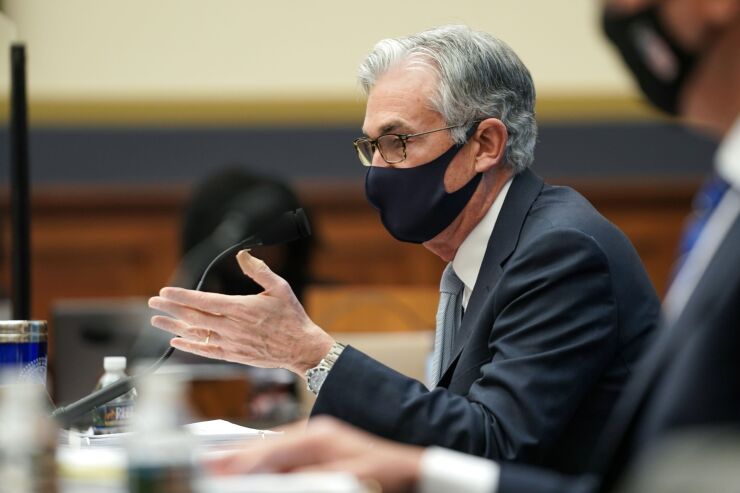WASHINGTON — The Federal Reserve is nearing a decision on whether to extend temporary capital relief given to banks last year to help them manage the economic fallout from the coronavirus pandemic, Fed Chair Jerome Powell told lawmakers Tuesday.
The Fed and other agencies last spring allowed banks subject to the supplementary leverage ratio to exclude U.S. Treasury securities and deposits at Federal Reserve banks from the measure of capital relative to assets. The exemptions, set to expire March 31, were meant to free up resources to make loans and other purposes.
While the central bank is still weighing its options, Powell indicated to members of the Senate Banking Committee that an extension is on the table. The deadline is also approaching on the relief provided by the Federal Deposit Insurance Corp. and Office of the Comptroller of the Currency.
“We have not decided what to do there yet, and we’re actually looking into that right now,” Powell said, adding that the Fed will announce a decision “pretty soon.”
The SLR requires banks with more than $250 billion of assets to maintain an extra cushion of high-quality capital against their total assets. Banks must maintain a minimum 3% ratio against their total leverage exposure. The ratio is 5% for the largest bank holding companies.

The temporary relief was intended to allow banks to expand their balance sheet and relieve some stress on the functioning of the Treasury market, but the Fed had also estimated that the change would reduce the required amount of capital at bank holding companies by $76 billion.
That elicited backlash from Democratic lawmakers and others who expressed concern about banks shedding capital in the midst of a crisis, and Tuesday's hearing revealed that the issue still divides lawmakers.
Senate Banking Committee Chair Sherrod Brown, D-Ohio, urged Powell not to extend the relief for any banks that have continued to pay dividends to shareholders “rather than invest in the real economy.”
“The Fed reduced capital standards so banks would lend more, not so they would pay dividends, but it’s not what’s happening,” said Brown. “The biggest banks have gotten larger, they’ve gotten more profitable, but they haven’t increased lending. Dividends, however, remain steady.”
But Powell told Brown that he didn’t think it would be appropriate to tie continued SLR relief to dividend payments.
“I’m not going to commit to connecting that decision to the payment of dividends as a separate matter,” Powell said. “What you see now is a banking system that has higher capital than it did going into the pandemic, and particularly for the largest banks.”
Powell said that the nation’s largest banks “proved resilient” throughout the past year amid the economic turmoil, and that he doesn't expect that to change.
“They’ve been able to keep lending, their capital levels have actually gone up during this period … so I think that the work that we did over the course of the last decade and then some has held up pretty well so far, and I expect it to continue,” he said.
Fed officials have already stated that they
If regulators choose not to extend the relief, some worry that it could result in banks being forced to turn away deposits, reduce reserves and cut back on payouts to shareholders.
"I certainly hope that to the extent that banks have adequate capital for the circumstances that they face at any point in time, any capital beyond that should absolutely be available to be returned to the people who own those banks in the form of dividends or stock buybacks,” said Sen. Pat Toomey of Pennsylvania, the top Republican on the committee. “Anything to the contrary is a terrible constraint on our economy and on economic freedom.”
Sen. Mike Rounds, R-S.D., added that the temporary exclusions of certain assets from the supplementary leverage ratio were “important in preserving bank liquidity.
“The chairman himself said that banks should be doing more to help their workers and our broader society, but they can’t do that when we’re tying their hands with excessive and challenging capital requirements,” Rounds said, referring to Brown.
Rounds noted that the $1.9 trillion stimulus plan backed by President Biden could place further stress on banks by injecting more liquidity.
“It would appear Congress is going to create even more bottlenecks in our financial plumbing by flooding the economy with about $1.9 trillion in new money that banks will have to hold capital against as soon as Treasury starts writing the checks,” Rounds said.





